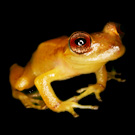

|
 |
 |
 |
 |
 |
 |
 |
 |  |
 |
 |
Merkmale |
Männchen 15-20 mm, Weibchen etwa 20 mm. Variable Rückenfärbung, hell- bis dunkelgrün, oliv oder bräunlich, meist mit zwei hellen Seitenlinien unregelmäßigen dunklen Flecken. Bauch gelblich. Schallblase unpaar. |
 |
 |  |  |
 |
 |
Verbreitung |
Argentinien und Uruguay, auch Vorkommen direkt an der Grenze zu Rio Grande do Sul (bisher allerdings noch kein Nachweis in RS selbst). |
 |
 |  |  |
 |
 |
Lebensraum |
Bewohnt permanente Gewässer auf offenen Grasflächen (campos). Aquatische Lebensweise. |
 |
 |  |  |
 |
 |
Biologie |
Männchen rufen sowohl tagsüber als auch nachts auf Wasserpflanzen an der Wasseroberfläche sitzend. Leiser, klickender Ruf. Die Gelege aus 50-150 grünlichen Eiern werden als Ballen zwischen Wasserpflanzen befestigt. |
 |
 |  |  |
 |
 |
Literatur |
Achaval, F. & A. Olmos (2003): Anfibios y reptiles del Uruguay. 2. edition. - Montevideo, Uruguay (Graphis Impresora), 136 pp.
Bosch, J., I. De la Riva, et al. (1996). The calling behaviour of Lysapsus limellus and Pseudis paradoxa (Amphibia: Anura: Pseudidae). Folia Zoologica 45(1): 49-55.
DurÉ, M. I. and A. I. Kehr (2001). Differential exploitation of trophic resources by two pseudid frogs from Corrientes, Argentina. J. Herpetol. 35(2): 340-343.
Gudynas, E. and J. C. Rudolf (1983). Nóta sobre la presencia de Lysapsus limellus limellus en Uruguay (Anura: Pseudidae). C.E.D. Orione Cont. Biol., Montevideo 9: 1-7.
Kehr, A. I. and N. G. Basso (1990). Description of the tadpole of Lysapsus limellus (Anura:Pseudidae) and some considerations on its biology. Copeia 1990(2): 573-575.
Langone, J.A. (1994): Ranas y sapos del Uruguay (Reconocimiento y aspectos biológicos). - Museo D. A. Larraņaga, Montevideo, Serie de Divulgación, 5: 1-123. |
 |
 |
|

